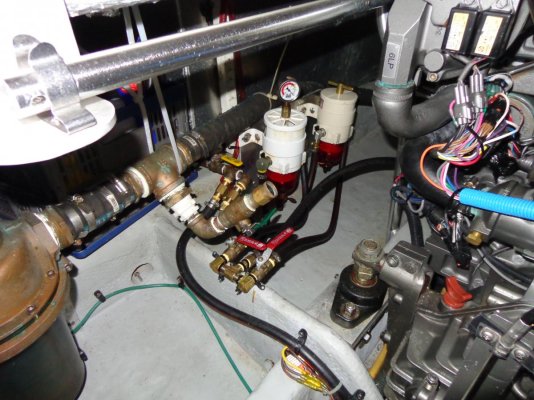We have a 1991 Cooper Yachts 28’ Prowler with a Volvo Penta TAMD41B mated to a VP 290DP leg. About 875 hours on it since new.
Boat’s been running beautifully - up to 28.2 knots an a smooth 23.5 cruise at 3750 RPM. Gets out of the hole and up on a plane quickly as soon as the turbo spools up.
Recently it’s started losing oil, about 1 litre per hour at cruising speed. No smoke except a tiny amount at idle when cold. A little of it ends up in the bilge, but most of it disappears. Dye tracers haven’t revealed any leaks at all.
A couple of mechanics have suggested a leaking seal in the turbo could be the culprit, burning the oil so completely that there’s no smoke. As there are no mechanics available before October I’ve just been topping up the oil as needed and checking it often. We’re leaving the country for 8-9 months, long before we could get a mechanic to look at it.
Yesterday we did a long cruise at 23 Knots, and as we neared our destination the engine suddenly started slowing dow, losing speed and coming down off the plane (down to 14 knots). Temperature had gone up about 3-4 degrees above the normal 173 degrees F.
As soon we stopped the boat (engine at close to idle) the temperature immediately dropped to normal idle temp (about 165F).
When I throttled up again, it was back to 23 Knots….but only for about 3 minutes, and then the process repeated. Eventually it was slowing down to 10 knots. Turbo gauge was reading 14 PSI boost (don’t know if that means normal atmospheric pressure of 14psi or 14 psi of boost above atmospheric, but I suspect the former…although at idle the gauge always reads zero…), which was full throttle at 10 knots.
When I run it again Tuesday morning I’ll get my wife to watch the turbo gauge (only at the lower helm station, and I always drive from the upper station for visibility - thousands of logs in these waters) and see what happens when it does it’s slow down thing. It kind of reminds me of a blockage in the muffler on my Mustang, choking off the exhaust - same loss of powe, exhaust got really hot, coolant temp started to rise.
I’ve checked the usual things available without disassembly, and all looks normal.
Hoping someone can offer some advice. We’re a long way from home with no mechanical assistance available…i
Boat’s been running beautifully - up to 28.2 knots an a smooth 23.5 cruise at 3750 RPM. Gets out of the hole and up on a plane quickly as soon as the turbo spools up.
Recently it’s started losing oil, about 1 litre per hour at cruising speed. No smoke except a tiny amount at idle when cold. A little of it ends up in the bilge, but most of it disappears. Dye tracers haven’t revealed any leaks at all.
A couple of mechanics have suggested a leaking seal in the turbo could be the culprit, burning the oil so completely that there’s no smoke. As there are no mechanics available before October I’ve just been topping up the oil as needed and checking it often. We’re leaving the country for 8-9 months, long before we could get a mechanic to look at it.
Yesterday we did a long cruise at 23 Knots, and as we neared our destination the engine suddenly started slowing dow, losing speed and coming down off the plane (down to 14 knots). Temperature had gone up about 3-4 degrees above the normal 173 degrees F.
As soon we stopped the boat (engine at close to idle) the temperature immediately dropped to normal idle temp (about 165F).
When I throttled up again, it was back to 23 Knots….but only for about 3 minutes, and then the process repeated. Eventually it was slowing down to 10 knots. Turbo gauge was reading 14 PSI boost (don’t know if that means normal atmospheric pressure of 14psi or 14 psi of boost above atmospheric, but I suspect the former…although at idle the gauge always reads zero…), which was full throttle at 10 knots.
When I run it again Tuesday morning I’ll get my wife to watch the turbo gauge (only at the lower helm station, and I always drive from the upper station for visibility - thousands of logs in these waters) and see what happens when it does it’s slow down thing. It kind of reminds me of a blockage in the muffler on my Mustang, choking off the exhaust - same loss of powe, exhaust got really hot, coolant temp started to rise.
I’ve checked the usual things available without disassembly, and all looks normal.
Hoping someone can offer some advice. We’re a long way from home with no mechanical assistance available…i
Last edited:

